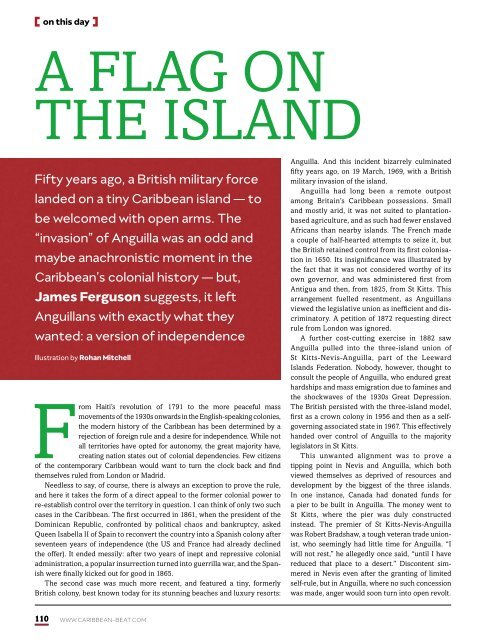Caribbean Beat — March/April 2019 (#156)
A calendar of events; music, film, and book reviews; travel features; people profiles, and much more.
A calendar of events; music, film, and book reviews; travel features; people profiles, and much more.
You also want an ePaper? Increase the reach of your titles
YUMPU automatically turns print PDFs into web optimized ePapers that Google loves.
on this day<br />
A flag on<br />
the island<br />
Fifty years ago, a British military force<br />
landed on a tiny <strong>Caribbean</strong> island <strong>—</strong> to<br />
be welcomed with open arms. The<br />
“invasion” of Anguilla was an odd and<br />
maybe anachronistic moment in the<br />
<strong>Caribbean</strong>’s colonial history <strong>—</strong> but,<br />
James Ferguson suggests, it left<br />
Anguillans with exactly what they<br />
wanted: a version of independence<br />
Illustration by Rohan Mitchell<br />
From Haiti’s revolution of 1791 to the more peaceful mass<br />
movements of the 1930s onwards in the English-speaking colonies,<br />
the modern history of the <strong>Caribbean</strong> has been determined by a<br />
rejection of foreign rule and a desire for independence. While not<br />
all territories have opted for autonomy, the great majority have,<br />
creating nation states out of colonial dependencies. Few citizens<br />
of the contemporary <strong>Caribbean</strong> would want to turn the clock back and find<br />
themselves ruled from London or Madrid.<br />
Needless to say, of course, there is always an exception to prove the rule,<br />
and here it takes the form of a direct appeal to the former colonial power to<br />
re-establish control over the territory in question. I can think of only two such<br />
cases in the <strong>Caribbean</strong>. The first occurred in 1861, when the president of the<br />
Dominican Republic, confronted by political chaos and bankruptcy, asked<br />
Queen Isabella II of Spain to reconvert the country into a Spanish colony after<br />
seventeen years of independence (the US and France had already declined<br />
the offer). It ended messily: after two years of inept and repressive colonial<br />
administration, a popular insurrection turned into guerrilla war, and the Spanish<br />
were finally kicked out for good in 1865.<br />
The second case was much more recent, and featured a tiny, formerly<br />
British colony, best known today for its stunning beaches and luxury resorts:<br />
Anguilla. And this incident bizarrely culminated<br />
fifty years ago, on 19 <strong>March</strong>, 1969, with a British<br />
military invasion of the island.<br />
Anguilla had long been a remote outpost<br />
among Britain’s <strong>Caribbean</strong> possessions. Small<br />
and mostly arid, it was not suited to plantationbased<br />
agriculture, and as such had fewer enslaved<br />
Africans than nearby islands. The French made<br />
a couple of half-hearted attempts to seize it, but<br />
the British retained control from its first colonisation<br />
in 1650. Its insignificance was illustrated by<br />
the fact that it was not considered worthy of its<br />
own governor, and was administered first from<br />
Antigua and then, from 1825, from St Kitts. This<br />
arrangement fuelled resentment, as Anguillans<br />
viewed the legislative union as inefficient and discriminatory.<br />
A petition of 1872 requesting direct<br />
rule from London was ignored.<br />
A further cost-cutting exercise in 1882 saw<br />
Anguilla pulled into the three-island union of<br />
St Kitts-Nevis-Anguilla, part of the Leeward<br />
Islands Federation. Nobody, however, thought to<br />
consult the people of Anguilla, who endured great<br />
hardships and mass emigration due to famines and<br />
the shockwaves of the 1930s Great Depression.<br />
The British persisted with the three-island model,<br />
first as a crown colony in 1956 and then as a selfgoverning<br />
associated state in 1967. This effectively<br />
handed over control of Anguilla to the majority<br />
legislators in St Kitts.<br />
This unwanted alignment was to prove a<br />
tipping point in Nevis and Anguilla, which both<br />
viewed themselves as deprived of resources and<br />
development by the biggest of the three islands.<br />
In one instance, Canada had donated funds for<br />
a pier to be built in Anguilla. The money went to<br />
St Kitts, where the pier was duly constructed<br />
instead. The premier of St Kitts-Nevis-Anguilla<br />
was Robert Bradshaw, a tough veteran trade unionist,<br />
who seemingly had little time for Anguilla. “I<br />
will not rest,” he allegedly once said, “until I have<br />
reduced that place to a desert.” Discontent simmered<br />
in Nevis even after the granting of limited<br />
self-rule, but in Anguilla, where no such concession<br />
was made, anger would soon turn into open revolt.<br />
110 WWW.CARIBBEAN-BEAT.COM


















